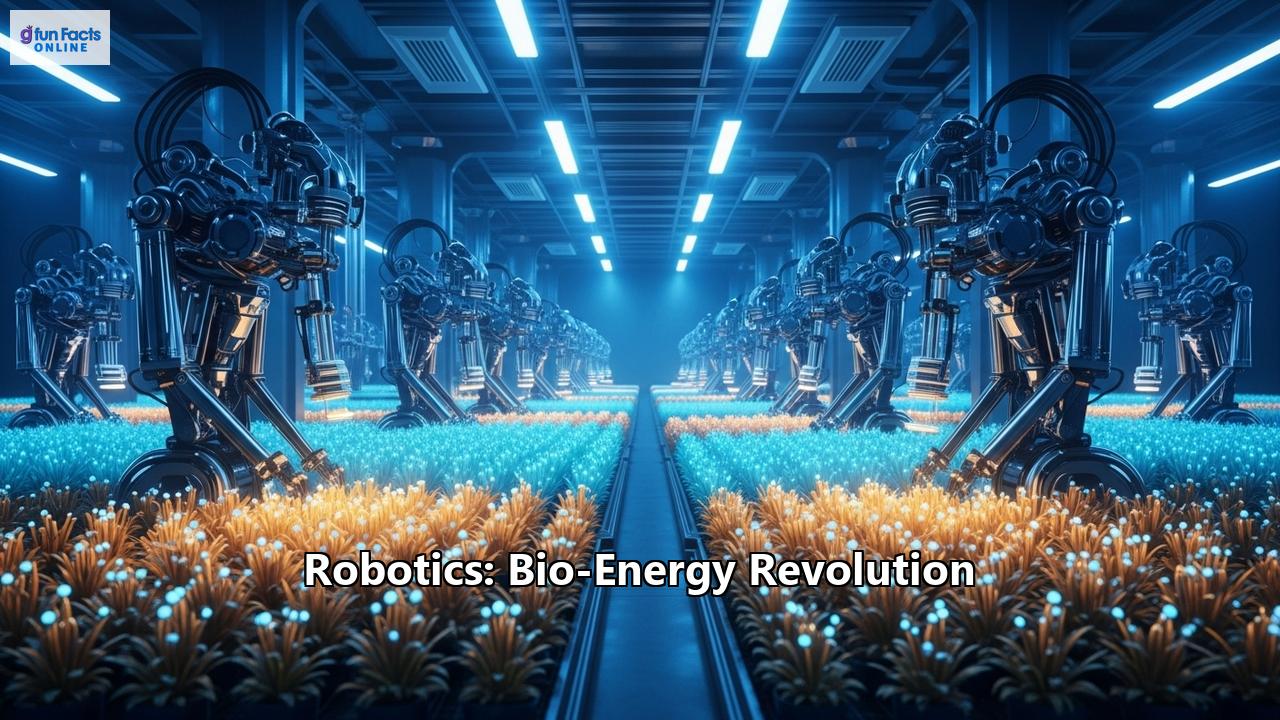In a world grappling with the urgent need for sustainable energy, a quiet but powerful revolution is underway at the intersection of two transformative fields: robotics and bio-energy. This synergy is not just about automating old processes; it is about fundamentally reimagining how we produce and utilize energy from organic matter. From intelligent robots that tend to energy crops to microscopic bio-hybrid systems that generate power, this burgeoning field promises to unlock a cleaner, more efficient, and sustainable energy future.
The Dawn of a New Era: Automating Bio-Energy from Field to Fuel
The traditional bio-energy supply chain, from cultivating biomass to converting it into fuel, has often been labor-intensive and inefficient. Robotics, supercharged with artificial intelligence (AI), is systematically dismantling these barriers.
Smarter Farming for a Greener Future:In the vast fields where energy crops are grown, a new generation of autonomous robots is taking over. Equipped with advanced sensors and AI algorithms, these robots can navigate agricultural landscapes with remarkable precision. They monitor crop health in real-time, optimize irrigation and fertilization, and even carry out targeted pest control, all of which maximizes biomass yield while minimizing resource consumption. This level of precision farming, made possible by robotics, not only boosts the productivity of biofuel feedstocks but also enhances the sustainability of the entire process. Automated systems are also being developed to aid in the planting, maintenance, and harvesting of biomass, making the process more efficient and expanding the range of usable land.
Optimizing the Conversion Process:Inside biorefineries, the transformation of raw biomass into usable biofuels is a complex dance of chemical and biological processes. Robotics and AI are proving to be invaluable choreographers in this dance. Automated systems can handle the sorting, shredding, and transportation of biomass materials, streamlining the entire workflow. AI algorithms analyze real-time data from within bioreactors, fine-tuning crucial parameters like temperature, pH, and enzyme concentrations to maximize biofuel yields and reduce energy input.
This intelligent oversight extends to the very catalysts of conversion. Scientists are harnessing the power of AI and machine learning to engineer and discover new, highly efficient enzymes for biofuel synthesis. These AI-driven platforms can rapidly design and test thousands of potential protein structures, identifying those that can effectively break down non-edible feedstocks like agricultural waste into fuel. Coupled with robotic assembly platforms, this process can produce and evaluate new enzyme candidates in a matter of days, a task that once took months with no guarantee of success.
The Rise of Bio-Hybrid Robotics: Where Life and Machine Converge
Perhaps the most fascinating frontier in the bio-energy revolution is the development of bio-hybrid robots. These pioneering systems merge living components, such as cells and tissues, with synthetic materials. This fusion aims to create robots that possess the remarkable adaptability, self-healing capabilities, and energy efficiency inherent in biological systems.
Living materials offer the promise of future sustainable robotics due to their intrinsic softness, environmental compatibility, and efficient energy conversion processes. Researchers are exploring the use of biological modules to serve as sensors, processors, and even power suppliers for robots. Imagine microscopic robots powered by microbial fuel cells that use symbiotic bacteria within their "digestive" systems to generate energy from organic waste. Other concepts include integrating algae-based bioreactors into robotic structures to produce biofuel on the go.
While still in the early stages, the potential of bio-hybrid robotics is immense. The U.S. Defense Advanced Research Projects Agency (DARPA) is actively researching ways to integrate biological elements to create robots that could outperform their purely synthetic counterparts. These nature-inspired designs could lead to breakthroughs in self-powered robotic systems, dramatically extending their operational lifespans and autonomy.
AI and Machine Learning: The Brains Behind the Revolution
Underpinning the entire robotics and bio-energy revolution is the power of artificial intelligence and machine learning. AI serves as the central nervous system, processing vast amounts of data to make intelligent decisions that optimize every stage of the bio-energy lifecycle.
- Predictive Analytics: AI-powered predictive models can forecast optimal harvest times for energy crops, predict potential equipment failures in biorefineries for proactive maintenance, and even anticipate fluctuations in energy demand.
- Supply Chain Optimization: By analyzing data on weather conditions, traffic patterns, and biomass availability, AI algorithms can optimize transportation routes and logistics, ensuring that the entire supply chain is as efficient and low-carbon as possible.
- Enhanced Autonomy: The continuous advancement of AI and machine learning is making robots increasingly autonomous and efficient. These intelligent robots can adapt to changing environmental conditions, optimize energy capture, and even make decisions without human intervention, further reducing costs and improving the sustainability of bio-energy operations.
Challenges and the Road Ahead
Despite the incredible promise, the path to a full-fledged bio-energy revolution powered by robotics is not without its obstacles. Technical challenges remain in developing fully autonomous robots capable of performing complex tasks in unpredictable environments. Furthermore, integrating these advanced robotic systems with smart grids to optimize energy production, storage, and distribution is a complex undertaking. For AI-accelerated innovation to truly deliver, there needs to be a concerted effort from policymakers and the scientific community to address gaps in data availability and the high computational costs associated with these advanced technologies.
Nevertheless, the future looks bright. The integration of robotics into the bio-energy sector is a rapidly growing field that is poised to transform how we produce and consume energy. As research and development continue to push the boundaries of what's possible, we can expect even more breakthroughs. From self-replicating robots inspired by nature to fully automated "self-driving" laboratories that accelerate the discovery of new biofuels, the synergy between robotics and bio-energy is an indispensable part of creating a cleaner, more resilient, and sustainable world for generations to come.
Reference:
- https://geckon.com/blog/comparing-renewable-energy-robotics--which-solutions-lead-the-market-
- https://www.ieabioenergyreview.org/wp-content/uploads/2022/12/IEA_BIOENERGY_REPORT.pdf
- https://www.ijcrt.org/papers/IJCRT2410183.pdf
- https://www.leadventgrp.com/blog/ai-and-big-data-in-optimizing-biofuel-production-and-efficiency
- https://www.researchcorridor.org/index.php/bget/article/download/216/207
- https://www.researchgate.net/publication/381075137_Introduction_of_machine_learning_and_artificial_intelligence_in_biofuel_technology
- https://scrivenerpublishing.com/cart/title.php?id=1141
- https://decisiveagents.com/ai-protein-design-flips-biofuel-game/
- https://www.iea.org/commentaries/how-will-artificial-intelligence-transform-energy-innovation
- https://www.militaryaerospace.com/computers/article/55262066/bio-hybrid-robots-offer-self-healing
- https://srl.ethz.ch/research/BiohybridRobotics.html
- https://library.fiveable.me/robotics-bioinspired-systems/unit-12/energy-harvesting/study-guide/FUz0K3I6d1eMVB8A
- https://www.enelgreenpower.com/learning-hub/debates/robotics-opportunities-risks
- https://www.discoverengineering.org/robotics-in-renewable-energy/

